Passive investing is no longer the safe strategy. Blindly rushing into active strategies is not a winning strategy either. There is no substitute for due diligence on the fundamentals of individual stocks, and investors cannot always trust that professional fund managers do that diligence.
Only our mutual fund ratings benefit from our uniquely rigorous diligence of fund holdings. This holdings diligence provides insights into the fundamentals of the overall fund so investors can determine whether or not a fund justifies its fees by sufficiently allocating to quality stocks. This week, we’ve identified a mutual fund with below average fees and higher-quality holdings than its benchmark.
Despite its 2-star Morningstar rating, Artisan Mid Cap Value Fund (ARTQX) earns our Attractive Risk/Reward rating and is this week’s Long Idea.
Our Research Looks Forward, Not Backward
Investors that rely solely on past performance may overlook this fund because it has underperformed its benchmark, the driver of its 2-star rating from Morningstar.
Our fund research is forward looking, not backward looking. When viewed through our Predictive Risk/Reward Fund Rating methodology, which leverages our superior research[1], ARTQX, along with APDQX and APHQX, earns an Attractive rating.
Figure 1: Artisan Mid Cap Value Fund Ratings

Sources: New Constructs, LLC, company filings, and Morningstar
ARTQX allocates significantly more capital to highly profitable companies with low profit growth expectations baked into their stock prices, which makes its portfolio higher quality than its benchmark.
Holdings Research Reveals a High-Quality Portfolio
Artisan Mid Cap Value Fund managers summarize their investment philosophy as follows:
“We seek cash-producing businesses in strong financial condition that are selling at undemanding valuations.”
From a fundamental perspective, the managers look for companies with “healthy balance sheets, strong liquidity, and financial flexibility” and take into account “on- and off-balance sheet liabilities when measuring financial condition.” To identify these firms, the managers generate investment ideas through a bottom-up process that focuses on:
- Free cash flow (FCF)
- Return on capital (similar to our return on invested capital)
From a valuation perspective, the managers invest in “low expectation situations” and stocks with “a high level of pessimism already baked into the stock.” If that sounds familiar, it’s because investing in stocks with high-quality earnings and low expectations for future growth in cash flows (as measured by our reverse DCF model) is a key aspect of our Value Investing 2.0 philosophy.
Mentioning these fundamental and valuation screens in a methodology is not enough to ensure a quality portfolio, though. The managers of the fund must show that they put their money where their mouth is and allocate capital according to their stated strategy. We’ve seen funds, such as Transamerica Capital Growth Fund (IALAX), Columbia Small Cap Growth Fund (CGOAX), MFS Mid Cap Growth Fund (OTCAX), and HSBC Opportunity Fund (HSOAX) with a seemingly good methodology on paper that have low-quality and overvalued holdings in practice.
We leverage our Robo-Analyst technology[2] to drill down and analyze the individual stocks for ~7,100 funds to assess holdings quality. Through this analysis, we know this fund’s investment strategy helps management pick more attractive stocks compared to its benchmark, the iShares Russell Mid-Cap ETF (IWR).
Per Figure 2, Artisan Mid Cap Value Fund’s asset allocation holds greater upside and provides less downside risk than its benchmark.
ARTQX allocates 43% of its portfolio to Attractive-or-better rated stocks compared to 24% for IWR. On the flip side, ARTQX’s exposure to Unattractive-or-worse rated stocks is much lower, at 25%, versus IWR at 36%.
Figure 2: ARTQX Allocates Capital to Superior Holdings

Sources: New Constructs, LLC and company filings
Given the favorable allocation relative to the benchmark, ARTQX appears well-positioned to capture more upside with lower risk. Compared to the average mutual fund, ARTQX has a much better chance of generating the outperformance required to justify its fees.
Superior Stock Selection Drives Superior Risk/Reward
By including return on capital and free cash flow in its stock-picking methodology, we would expect ARTQX’s managers to find high-quality companies (as measured by ROIC) with lower-risk valuation. And, they do.
Figure 3 contains our detailed rating for ARTQX, which includes each of the criteria we use to rate all funds under coverage. These criteria are the same for our Stock Rating Methodology because the performance of a fund’s holdings equals the performance of a fund after fees.
Figure 3: Artisan Mid Cap Value Fund Rating Breakdown
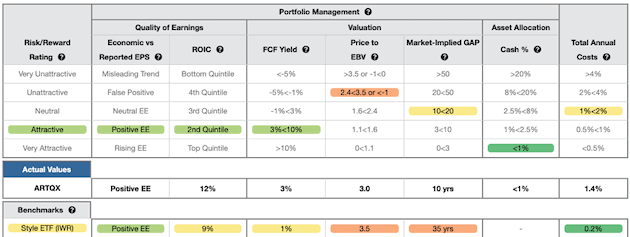
Sources: New Constructs, LLC and company filings
As Figure 3 shows, ARTQX’s holdings are superior to its benchmark (click here for our report on IWR) in four of the five criteria that make up our holdings/Portfolio Management analysis. Specifically:
- ARTQX’s ROIC is 12% and greater than the 9% earned by IWR holdings.
- ARTQX’s free cash flow yield of 3% is higher than the 1% of IWR.
- The price-to-economic book value (PEBV) ratio for ARTQX is 3.0, which is lower than the 3.5 for IWR holdings.
- Our discounted cash flow analysis reveals an average market implied growth appreciation period (GAP) of 10 years for ARTQX’s holdings compared to 35 years for IWR.
In other words, the stocks held by ARTQX generate greater cash flows and have cheaper valuations compared to IWR. The market expectations for stocks held by ARTQX imply profit growth (measured by PEBV ratio) that is below the profit growth expectations embedded in IWR’s holdings. Higher historical profits and lower expectations for future profits are a textbook case of investing in “low expectations.”
Costs – An Important Consideration for Fund Investors
In addition to evaluating the underlying holdings of a fund, investors must also evaluate its costs. Not only does Artisan Mid Cap Value Fund offer high-quality stock selection, it does so at a reasonable price. Its total annual costs (TAC), at 1.39%, are below the 1.66% average of the 368 Mid Cap Blend mutual funds and the 1.73% average of all mutual funds under coverage. Figure 4 shows our breakdown of ARTQX’s total annual costs, which is available for all of the ~7,100 mutual funds under coverage.
Figure 4: Artisan Mid Cap Value Fund Total Annual Costs Breakdown
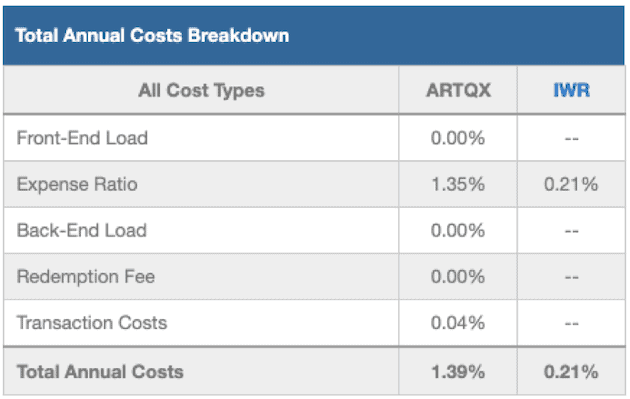
Sources: New Constructs, LLC and company filings
A Closer Look at a Quality Holding
Omnicom Group (OMC: $56/share) is one of ARTQX’s many quality holdings and one we recently featured as a Long Idea. Omnicom fits ARTQX’s stated investing philosophy well as it has a high level of pessimism baked into its stock.
Per Figure 5, Omnicom has grown revenue by 2% compounded annually and core earnings by 5% compounded annually over the past decade. Longer term, Omnicom has grown core earnings by 7% compounded annually over the past two decades. The firm increased its core earnings margin from 7% in 2009 to 9% in the trailing-twelve-month (TTM) period and improved its ROIC from 10% to 14% over the same time.
Figure 5: Omnicom’s Revenue & Core Earnings Since 2009
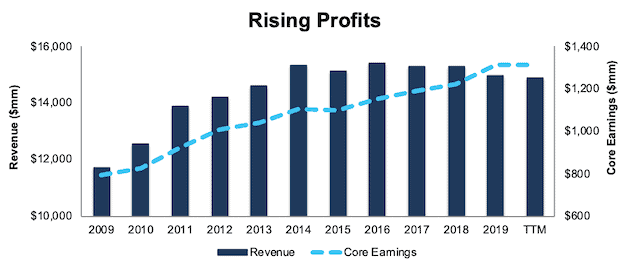
Sources: New Constructs, LLC and company filings
A High Level of Pessimism Is Baked into OMC’s Current Price
At its current price of $56/share, OMC trades at its cheapest price-to-economic book value (PEBV) ratio, 0.4, in the history of our model. This ratio means the market expects OMC’s NOPAT to permanently decline by 60%. This expectation seems overly pessimistic over the long term.
Omnicom’s current economic book value, or no-growth value, is $134/share – 139% upside to the current price.
Below, we use our reverse DCF model to quantify the cash flow expectations baked into OMC’s current stock price. Our analysis reveals OMC holds significant upside potential even if the economy only moderately recovers.
Scenario 1: Using historical revenue declines and margins, as well as average historical GDP growth rates, we can model the worst-case scenario already implied by Omnicom’s current stock price. In this scenario, we assume:
- Net operating profit after-tax (NOPAT) margins fall to 8% (all-time company low in 2001) in 2020-2024 before rebounding to 9% (10-year average vs. 11% TTM) in 2025 and each year thereafter
- Revenue falls 26% in 2020, (double the YoY decline from 2008 to 2009) and 13% in 2021 and 2022
- Sales begin growing again in 2023, but only at 3.5% a year, which equals the average global GDP growth rate since 1961
In this scenario, where Omnicom’s NOPAT declines 6% compounded annually over the next nine years (including a 45% YoY decline in 2020), the stock is worth $56/share today – equal to the current stock price. This scenario accounts for the debt issuance since the end of 1Q20. We conservatively assume this capital will be used to cover operating expenses and do not treat it as excess cash. See the math behind this reverse DCF scenario.
For reference, Omnicom’s NOPAT declined by 2% compounded annually from 2008 to 2011 before growing by 4% compounded annually over the next eight years.
Figure 6 compares the firm’s implied future NOPAT to its historical NOPAT in this scenario. This worst-case scenario implies Omnicom’s NOPAT nine years from now will be 42% below its 2019 NOPAT. In other words, this scenario implies that nine years after the COVID-19 pandemic, Omnicom’s profits will have only recovered to ~2004 levels. Per Figure 6, Omnicom has surpassed this implied level of profit every year since 2004. In any scenario better than this one, OMC holds significant upside potential, as we’ll show below.
Figure 6: Current Valuation Implies Severe, Long-Term Decline in Profits: Scenario 1
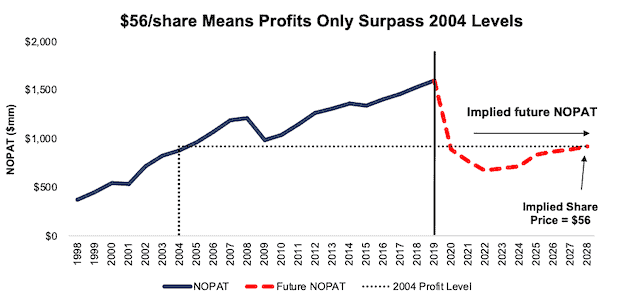
Sources: New Constructs, LLC and company filings.
Scenario 2: Big Upside Without a Full Recovery
If we assume, as does the International Monetary Fund (IMF) and nearly every economist in the world, that the global economy grows strongly in 2021, OMC looks even more undervalued.
In this scenario, we assume:
- NOPAT margins fall to 8% (all-time company low) in 2020 and rebound to 9% (10-year average) in 2021 and each year thereafter
- Revenue falls 26% in 2020 – twice the year-over-year revenue decline from 2008 to 2009
- Revenue growth returns in 2021 at the IMF’s global base-case GDP growth rate of 5.8%
- Revenue grows at 3.5% a year thereafter, which equals the average global GDP growth rate since 1961
In this scenario, where Omnicom’s NOPAT declines by 1% compounded annually over the next decade (and falls 45% YoY in 2020), the stock is worth $97/share today – a 73% upside to the current price. This scenario also accounts for the debt issuance since the end of 1Q20. We conservatively assume this capital will be used to cover operating expenses and do not treat it as excess cash. See the math behind this reverse DCF scenario.
For comparison, Omnicom has grown NOPAT by 5% compounded annually over the past decade and 7% compounded annually over the past two decades. It’s not often investors get the opportunity to buy an industry leader at such a discounted price.
Figure 7 compares the firm’s implied future NOPAT to its historical NOPAT in scenario 2. This moderate scenario implies that a decade from now, Omnicom’s NOPAT will still be 13% below 2019 levels and have only recovered to ~2015 levels. If the firm’s profits return to these levels in less than 10 years, OMC has even more upside potential.
Figure 7: Implied Profits with Moderate Global Recovery: Scenario 2
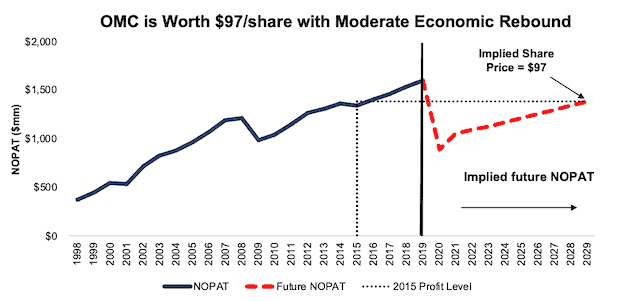
Sources: New Constructs, LLC and company filings.
Not All Holdings Are High-Quality
Despite managers having a majority of ARTQX’s portfolio allocated to high-quality stocks, there is still room for improvement.
Kirby Corporation (KEX: $53/share) is one of ARTQX’s worst holdings due to its growing losses, low ROIC, and overvalued stock price. Since 2014, Kirby’s revenue has grown by 2% compounded annually while core earnings have declined 17% compounded annually. See Figure 8.
Figure 8: Kirby Corporation’s Revenue & Core Earnings Since 2014
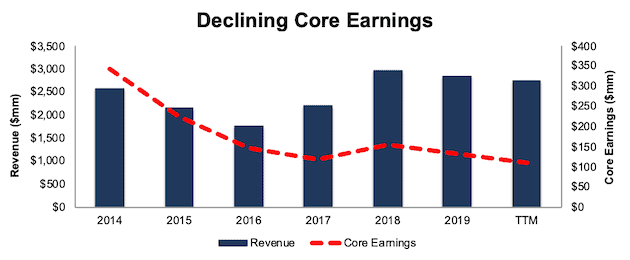
Sources: New Constructs, LLC and company filings
Economic earnings, which not only account for unusual items on the income statement but also changes to the balance sheet, look even worse. Economic earnings have declined from $109 million in 2014 to -$167 million TTM. Kirby’s ROIC has fallen from 10% in 2014 to a bottom-quintile 3% TTM.
KEX is Significantly Overvalued
Despite the deterioration in Kirby’s fundamentals, shares remain significantly overvalued.
To justify its current price of $53/share, KEX must immediately improve margins to 7% (which would be the highest margin since 2016, compared to 5.6% TTM) and grow NOPAT by 6% compounded annually for the next decade. See the math behind this reverse DCF scenario. For reference, Kirby’s NOPAT has fallen by 13% compounded annually since 2014 and only grown by 2% compounded annually over the past decade.
This scenario also implies Kirby’s NOPAT grows 18% YoY in 2020 compared to the consensus estimate for a 25% decline in EPS over the same period.
Figure 9 compares the firm’s implied future NOPAT to its NOPAT since 2014 for this scenario. This scenario implies Kirby’s NOPAT 10 years from now will be $326 million compared to $153 million TTM or 113% higher. In any scenario worse than this one, such as one that includes a COVID-19 related drop in profits, KEX holds significant downside risk, as we’ll show.
Figure 9: Current Valuation Implies Drastic Improvement in Profits: Scenario 1
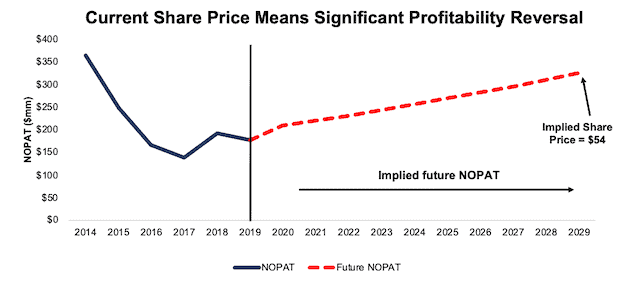
Sources: New Constructs, LLC and company filings.
Even if we assume Kirby can maintain 2019 margins (6.3%, compared to 5.6% TTM) and grow NOPAT by 4% compounded annually for the next decade, the stock is worth only $35/share today – a 34% downside to the current stock price. See the math behind this reverse DCF scenario.
Figure 10 compares the firm’s implied future NOPAT to its NOPAT since 2014 for this scenario.
Figure 10: KEX Has Significant Downside Risk: Scenario 2
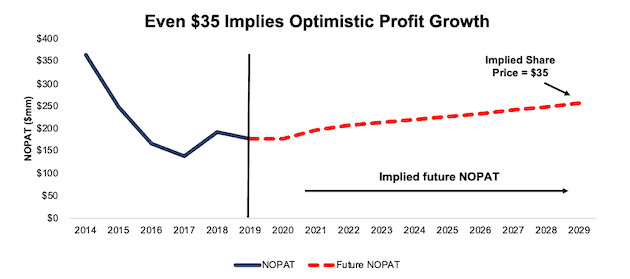
Sources: New Constructs, LLC and company filings.
Each of these scenarios also assumes Kirby is able to grow revenue, NOPAT, and FCF without increasing working capital or fixed assets. This assumption is unlikely but allows us to create best-case scenarios that demonstrate how high expectations embedded in the current valuation are. For reference, Kirby’s invested capital grew by an average of $421 million a year (15% of 2019 revenue) over the past decade.
Luckily for investors, Kirby Corporation appears to be an outlier in what is largely a strong portfolio.
The Importance of Holdings Based Fund Analysis
Smart fund (or ETF) investing means analyzing the holdings of each mutual fund. Failure to do so is a failure to perform proper due diligence. Simply buying a mutual fund or ETF based on past performance does not necessarily lead to outperformance. Similarly, blindly diversifying through index funds is no substitute for diligence. Only through holdings-based analysis can one determine if a fund’s methodology leads managers to pick high-quality or low-quality stocks.
However, most investors don’t realize they can access sophisticated fundamental research[3] using data that corrects market inefficiencies and generates alpha. Our Robo-Analyst technology analyzes the holdings of all 387 ETFs and mutual funds in the Mid Cap Blend style and ~7,800 ETFs and mutual funds under coverage to avoid “the danger within.” This diligence allows us to cut through the noise and identify mutual funds, like Artisan Mid Cap Value Fund, with a portfolio and methodology that suggest future performance will be strong.
This article originally published on June 3, 2020.
Disclosure: David Trainer, Kyle Guske II, and Matt Shuler receive no compensation to write about any specific stock, style, or theme.
Follow us on Twitter, Facebook, LinkedIn, and StockTwits for real-time alerts on all our research.
[1] Our core earnings are a superior measure of profits, as demonstrated in In Core Earnings: New Data & Evidence a paper by professors at Harvard Business School (HBS) & MIT Sloan. The paper empirically shows that our data is superior to “Income Before Special Items” from Compustat, owned by S&P Global (SPGI).
[2] Harvard Business School features the powerful impact of our research automation technology in the case study New Constructs: Disrupting Fundamental Analysis with Robo-Analysts.
[3] This paper compares our analytics on a mega cap company to Bloomberg and Capital IQ (SPGI) in a detailed appendix.
